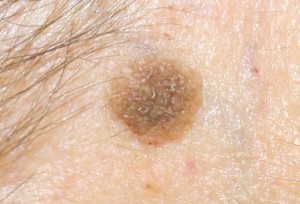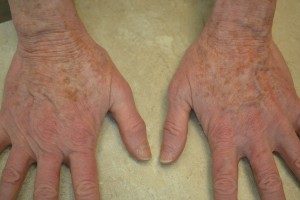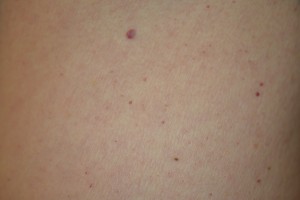Common Spots
What Are These Brown Spots, Red Spots, & White Spots?
What are these and why are they popping up on your skin? As we get older (and wiser), it is almost inevitable that different color skin growths will appear on your skin. Here is a review of some of the most common things you may see.
Brown Spots
Seborrheic Keratosis:
These are by far the most common benign lesions that dermatologists see on the skin of adults. Also referred to as “age spots”, “barnacles” or “wisdom spots” these growths appear as though someone has literally pasted them onto the skin. They are usually tan, yellow-hued, or brown, but can be almost any color in between. Some people will have one, while others (with a genetic tendency) may have hundreds! These benign growths have no cancerous potential and are not dangerous, but they can be unsightly, and occasionally itchy. Sometimes they can be flat and dark brown and can be difficult to distinguish from an abnormal mole. If you have any question whatsoever about a new dark spot on your skin, you should be examined by a dermatologist.

Sadly, there is no great cream or medication to use at home to improve seborrheic keratoses. Your dermatologist can treat them cosmetically with liquid nitrogen; however, this procedure is not covered by your insurance. Freezing does carry the risk of leaving a light mark behind.
Solar Lentigo:
Solar lentigines (also known as “freckles” or “sun damage spots”) are usually found on the chest, upper back, and face. What do all of those locations have in common? They are hot spots for excessive sun exposure and sunburn. Over time, the body responds to ultraviolet light by increasing local proliferation of melanocytes (the color cells in your skin). These spots are more common in fair skin individuals but can be seen in all skin types. These spots should be all one color with very sharp borders, but can often be difficult to distinguish from an abnormal mole or even melanoma. If your solar lentigo is more than one color, raised in any area, if you notice abnormal borders, or if you have any concern that one of your spots is abnormal, you should schedule an appointment to see your dermatologist. Excellent treatment options for solar lentigines are available. In our office we love Intense Pulsed Light (IPL) photorejuvenation the Fraxel® Dual Laser and Clear and Brilliant laser skin resurfacing.

Red Spots
Cherry Angioma:
Cherry angiomas are collections of superficial blood vessels. Like many benign growths, these tend to pop up with age and genetic tendency. You may have one or you may have hundreds and they can be found literally anywhere on your body. These growths may vary in size and can be flat or raised off of the skin. They range in color from bright “cherry” red to slightly purple. The great news is that they are absolutely not harmful and have no malignant potential. If you are interested in treatment, our V-Beam Prima laser can make them disappear. Of course, if you have a red spot that is growing, bleeding, has color variation, or is changing in any way, we recommend that you have these evaluated by a dermatologist.

White Spots
Idiopathic Guttate Hypomelanosis:
This long and very intimidating name really just means “small circular white spots whose cause is unknown.” Usually found in people with lighter skin, these spots are very common in areas of excessive sun exposure such as the arms, legs, and chest. While the true cause remains elusive, many have postulated that these are the result of both age and extreme ultraviolet damage to the skin.
Although there are no treatments for the white spots themselves, improvement in the surrounding sun damage can often make the entire area look better. Treatments include intense pulsed light (IPL) photorejuvenation and the Fraxel® Dual Laser.

